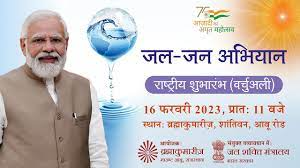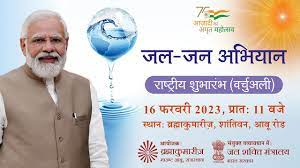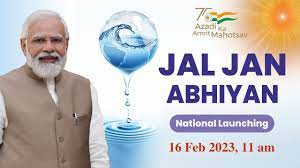Jal Jan Abhiyan: Revitalizing Water Resources for Sustainable Development

Introduction
Water is a vital resource essential for the survival and development of all living beings. However, with increasing population and rapid urbanization, demand for water has reached unprecedented levels. In order to address the pressing water crisis and ensure sustainable development, the government of India has initiated the Jal Jan Abhiyan. This article explores the significance of Jal Jan Abhiyan, its objectives, key components, implementation strategies, impact, and challenges faced in its execution.
What is Jal Jan Abhiyan?
Jal Jan Abhiyan, translated as the “People’s Water Campaign,” is an ambitious program launched by the Indian government to promote water conservation, rejuvenation of water bodies, and efficient utilization of water resources. It aims to create a mass movement for water conservation and management, involving the active participation of citizens, government agencies, non-profit organizations, and other stakeholders.
Importance of Jal Jan Abhiyan

Water scarcity is a pressing issue in India, with many regions facing acute water shortages. Jal Jan Abhiyan recognizes the importance of water in various sectors such as agriculture, industry, and domestic use. By creating awareness about water conservation, the campaign aims to ensure the availability of water for present and future generations. It also emphasizes the need to maintain ecological balance and protect natural water resources.
Objectives of Jal Jan Abhiyan
The primary objectives of Jal Jan Abhiyan are:
- To promote water conservation practices at the individual, community, and institutional levels.
- To rejuvenate traditional water bodies such as ponds, lakes, and rivers.
- To ensure efficient utilization of water through the adoption of modern irrigation techniques.
- To create awareness about rainwater harvesting and its importance in augmenting water resources.
- To implement water management strategies for sustainable agriculture and rural development.
- To improve water supply infrastructure in urban and rural areas.
- To promote the reuse and recycling of water for various purposes.
- To involve local communities in water governance and decision-making processes.
Key Components of Jal Jan Abhiyan

The Jal Jan Abhiyan comprises several key components that collectively contribute to its success:
- Awareness and Education: Conducting awareness campaigns, workshops, and seminars to educate people about the importance of water conservation and efficient water management.
- Water Rejuvenation: Restoring and rejuvenating traditional water bodies such as ponds, lakes, and step wells to increase water storage capacity and improve groundwater levels.
- Rainwater Harvesting: Promoting the installation of rainwater harvesting systems in residential, commercial, and institutional buildings to capture and store rainwater for future use.
- Water Infrastructure Development: Investing in the development of water supply infrastructure, including pipelines, water treatment plants, and storage facilities, to ensure reliable and safe water supply to communities.
- Agricultural Practices: Encouraging farmers to adopt water-efficient agricultural practices such as drip irrigation, sprinkler systems, and crop rotation to minimize water wastage and increase crop productivity.
- Water Governance: Promoting community participation in water governance through the formation of water user associations and involving local communities in decision-making processes related to water management.
Implementation of Jal Jan Abhiyan
The implementation of Jal Jan Abhiyan involves collaboration between various stakeholders, including government agencies, non-governmental organizations, local communities, and citizens. The government provides financial assistance, technical support, and capacity building to implement water conservation projects at the grassroots level. Non-profit organizations and community-based initiatives play a crucial role in mobilizing people and creating awareness about the campaign’s objectives. Read also- Jal Shakti Abhiyan UPSC
Impact and Benefits

The Jal Jan Abhiyan has yielded significant impact and benefits since its inception. Some of the key outcomes include:
- Increased Water Availability: Through the rejuvenation of water bodies and adoption of water conservation practices, the campaign has resulted in increased water availability for both agricultural and domestic purposes.
- Improved Groundwater Levels: Restoring traditional water bodies has contributed to the replenishment of groundwater reserves, ensuring a sustainable water supply for future generations.
- Enhanced Agricultural Productivity: The adoption of water-efficient irrigation techniques and improved agricultural practices has led to increased crop productivity and income for farmers.
- Empowered Local Communities: By involving local communities in water management and decision-making, the campaign has empowered them to take ownership of their water resources and ensure their sustainability.
- Mitigation of Water-Related Disasters: The campaign’s focus on flood management, watershed development, and early warning systems has helped mitigate the impact of water-related disasters, protecting lives and livelihoods. Read more
Challenges and Solutions
While the Jal Jan Abhiyan has achieved significant progress, it faces several challenges that need to be addressed:
- Water Pollution: Contamination of water bodies due to industrial effluents and improper waste disposal poses a significant challenge. Strict enforcement of pollution control regulations and public awareness campaigns can help address this issue.
- Climate Change: Changing weather patterns and unpredictable rainfall pose challenges for water resource management. Implementing climate-resilient water management strategies and promoting water-efficient practices can help mitigate the impacts of climate change.
- Funding and Resources: Adequate funding and resources are essential for the successful implementation of the campaign. Public-private partnerships, international collaborations, and innovative financing mechanisms can help overcome resource constraints.
- Community Engagement: Ensuring active participation and ownership of local communities is crucial for the long-term success of the campaign. Continuous engagement, capacity building, and incentivization can encourage community involvement.
Success Stories
Several success stories have emerged from the implementation of Jal Jan Abhiyan across different states in India. One such example is the restoration of a polluted lake in a rural village, which has not only improved the water quality but also become a tourist attraction, boosting the local economy. Another success story involves the adoption of drip irrigation techniques by farmers, resulting in increased crop yield and reduced water consumption.
Conclusion
Jal Jan Abhiyan is a transformative initiative aimed at addressing the water crisis in India through collective action and sustainable water management practices. By involving citizens, communities, and various stakeholders, the campaign has made significant strides in conserving water resources, rejuvenating water bodies, and ensuring water security for future generations. However, continued efforts, investments, and policy support are needed to overcome the challenges and achieve long-term sustainability.
FAQs
How can individuals contribute to the Jal Jan Abhiyan?
Individuals can contribute to the Jal Jan Abhiyan by adopting water conservation practices in their daily lives, participating in awareness campaigns, and promoting rainwater harvesting and reuse.
What are the economic benefits of the Jal Jan Abhiyan?
The Jal Jan Abhiyan brings economic benefits through increased agricultural productivity, job creation in the water management sector, and the development of eco-tourism around restored water bodies.
Is the Jal Jan Abhiyan limited to rural areas only?
No, the Jal Jan Abhiyan is implemented in both rural and urban areas, addressing the unique water management challenges faced by each.
How does the Jal Jan Abhiyan promote community participation?
The Jal Jan Abhiyan encourages the formation of user associations and involves local communities in decision-making processes related to water management, ensuring their active participation and ownership.
Can the Jal Jan Abhiyan be replicated in other countries?
While the Jal Jan Abhiyan is specific to India, its principles and strategies can serve as a valuable framework for other countries facing similar water management challenges.
2 thoughts on “Jal Jan Abhiyan”